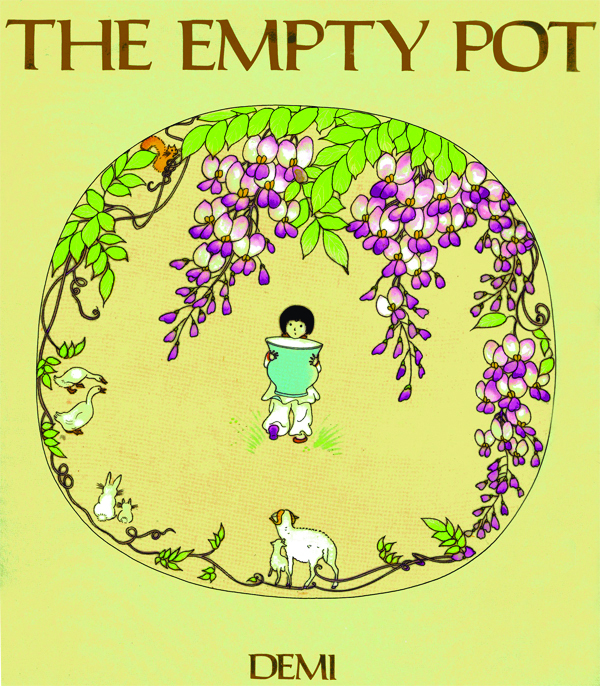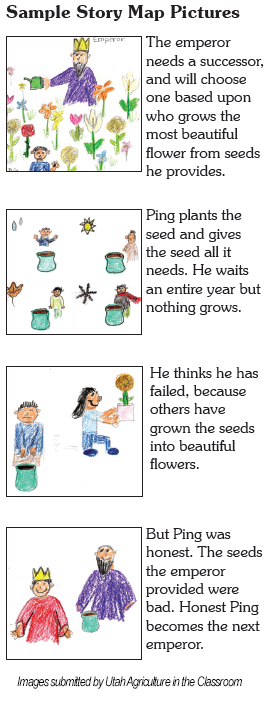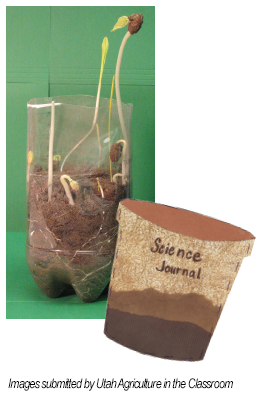Growing Plants in Science and Literature, More Than an Empty Pot (Grades K-2)
Students use the story of The Empty Pot to explore literature and science, practicing story mapping and examining the needs of plants and the importance of soil and water. Like the characters in the story, students plant and observe the growth of seeds.
Background
Lesson Activities
Recommended Companion Resources
Credits
Author
Vanae Morris | Utah Agriculture in the Classroom
Standards
Texas Content Area Standards
-
ELA: K.110.2.b.1
Developing and sustaining foundational language skills: listening, speaking, discussion, and thinking - - oral language. The student develops oral language through listening, speaking, and discussion.
- ELA: K.1.C: The student is expected to share information and ideas by speaking audibly and clearly using the conventions of language.
- ELA: K.1.D: The student is expected to work collaboratively with others by following agreed-upon rules for discussion, including taking turns.
-
ELA: K.110.2.b.5
Comprehension skills: listening, speaking, reading, writing, and thinking using multiple texts. The student uses metacognitive skills to both develop and deepen comprehension of increasingly complex texts.
- ELA: K.5.G: The student is expected to evaluate details to determine what is most important with adult assistance.
- ELA: K.5.H: The student is expected to synthesize information to create new understanding with adult assistance.
-
ELA: K.110.2.b.6
Response skills: listening, speaking, reading, writing, and thinking using multiple texts. The student responds to an increasingly challenging variety of sources that are read, heard, or viewed.
- ELA: K.6.D: The student is expected to retell texts in ways that maintain meaning.
- ELA: K.6.E: The student is expected to interact with sources in meaningful ways such as illustrating or writing.
-
ELA: K.110.2.b.7
Multiple genres: listening, speaking, reading, writing, and thinking using multiple texts -- literary elements. The student recognizes and analyzes literary elements within and across increasingly complex traditional, contemporary, classical, and diverse literary texts.
- ELA: K.7.B: The student is expected to identify and describe the main character(s).
- ELA: K.7.C: The student is expected to describe the elements of plot development, including the main events, the problem, and the resolution of texts read aloud with adult assistance.
- ELA: K.7.D: The student is expected to describe the setting.
-
ELA: K.110.2.b.8
Multiple genres: listening, speaking, reading, writing, and thinking using multiple texts -- genres. The student recognizes and analyzes genre-specific characteristics, structures, and purposes within and across increasingly complex traditional, contemporary, classical, and diverse texts.
- ELA: K.8.A: The student is expected to demonstrate knowledge of distinguishing characteristics of well-known children's literature such as folktales, fables, fairy tales, and nursery rhymes.
-
ELA: 1.110.3.b.1
Developing and sustaining foundational language skills: listening, speaking, discussion, and thinking - - oral language. The student develops oral language through listening, speaking, and discussion.
- ELA: 1.1.C: The student is expected to share information and ideas about the topic under discussion, speaking clearly at an appropriate pace and using the conventions of language.
- ELA: 1.1.D: The student is expected to work collaboratively with others by following agreed-upon rules for discussion, including listening to others, speaking when recognized, and making appropriate contributions.
-
ELA: 1.110.3.b.2
Developing and sustaining foundational language skills: listening, speaking, reading, writing, and thinking - - beginning reading and writing. The student develops word structure knowledge through phonological awareness, print concepts, phonics, and morphology to communicate, decode, and spell.
- ELA: 1.2.F: The student is expected to develop handwriting by printing words, sentences, and answers legibly leaving appropriate spaces between words.
-
ELA: 1.110.3.b.6
Comprehension skills: listening, speaking, reading, writing, and thinking using multiple texts. The student uses metacognitive skills to both develop and deepen comprehension of increasingly complex texts.
- ELA: 1.6.G: The student is expected to evaluate details to determine what is most important with adult assistance.
- ELA: 1.6.H: The student is expected to synthesize information to create new understanding with adult assistance.
-
ELA: 1.110.3.b.7
Response skills: listening, speaking, reading, writing, and thinking using multiple texts. The student responds to an increasingly challenging variety of sources that are read, heard, or viewed.
- ELA: 1.7.D: The student is expected to retell texts in ways that maintain meaning.
- ELA: 1.7.E: The student is expected to interact with sources in meaningful ways such as illustrating or writing.
-
ELA: 1.110.3.b.8
Multiple genres: listening, speaking, reading, writing, and thinking using multiple texts -- literary elements. The student recognizes and analyzes literary elements within and across increasingly complex traditional, contemporary, classical, and diverse literary texts.
- ELA: 1.8.B: The student is expected to describe the main character (s) and the reason (s) for their actions.
- ELA: 1.8.C: The student is expected to describe plot elements, including the main events, the problem, and the resolution, for texts read aloud and independently.
- ELA: 1.8.D: The student is expected to describe the setting.
-
ELA: 1.110.3.b.9
Multiple genres: listening, speaking, reading, writing, and thinking using multiple texts -- genres. The student recognizes and analyzes genre-specific characteristics, structures, and purposes within and across increasingly complex traditional, contemporary, classical, and diverse texts.
- ELA: 1.9.A: The student is expected to demonstrate knowledge of distinguishing characteristics of well-known children's literature such as folktales, fables, fairy tales, and nursery rhymes.
-
ELA: 2.110.4.b.1
Developing and sustaining foundational language skills: listening, speaking, discussion, and thinking -- oral language. The student develops oral language through listening, speaking, and discussion.
- ELA: 2.1.C: The student is expected to share information and ideas that focus on the topic under discussion, speaking clearly at an appropriate pace and using the conventions of language.
- ELA: 2.1.D: The student is expected to work collaboratively with others by following agreed-upon rules for discussion, including listening to others, speaking when recognized, making appropriate contributions, and building on the ideas of others.
-
ELA: 2.110.4.b.6
Comprehension skills: listening, speaking, reading, writing, and thinking using multiple texts. The student uses metacognitive skills to both develop and deepen comprehension of increasingly complex texts.
- ELA: 2.6.G: The student is expected to evaluate details read to determine key ideas.
- ELA: 2.6.H: The student is expected to synthesize information to create new understanding.
-
ELA: 2.110.4.b.7
Response skills: listening, speaking, reading, writing, and thinking using multiple texts. The student responds to an increasingly challenging variety of sources that are read, heard, or viewed.
- ELA: 2.7.D: The student is expected to retell and paraphrase texts in ways that maintain meaning and logical order.
- ELA: 2.7.E: The student is expected to interact with sources in meaningful ways such as illustrating or writing.
-
ELA: 2.110.4.b.8
Multiple genres: listening, speaking, reading, writing, and thinking using multiple texts -- literary elements. The student recognizes and analyzes literary elements within and across increasingly complex traditional, contemporary, classical, and diverse literary texts.
- ELA: 2.8.B: The student is expected to describe the main character's (characters') internal and external traits.
- ELA: 2.8.C: The student is expected to describe and understand plot elements, including the main events, the conflict, and the resolution, for texts read aloud and independently.
- ELA: 2.8.D: The student is expected to describe the importance of the setting.
-
ELA: 2.110.4.b.9
Multiple genres: listening, speaking, reading, writing, and thinking using multiple texts -- genres. The student recognizes and analyzes genre-specific characteristics, structures, and purposes, within and across increasingly complex traditional, contemporary, classical, and diverse texts.
- ELA: 2.9.A: The student is expected to demonstrate knowledge of distinguishing characteristics of well-known children's literature such as folktales, fables, and fairy tales.
-
Social Studies: 2.113.13.c.16
Social studies skills. The student communicates in written, oral, and visual forms. The student is expected to:
- Social Studies: 2.113.13.c.16.E: communicate information visually, orally, or in writing based on knowledge and experiences in social studies
- Social Studies: 2.113.13.c.16.F: create written and visual material such as stories, maps, and graphic organizers to express ideas
-
Social Studies: K.113.11.c.13
Social studies skills. The student applies critical-thinking skills to organize and use information acquired from a variety of valid sources, including technology. The student is expected to:
- Social Studies: K.113.11.c.13.D: sequence and categorize information
-
Social Studies: K.113.11.c.14
Social studies skills. The student communicates in oral and visual forms. The student is expected to:
- Social Studies: K.113.11.c.14.C: communicate information visually, orally, or in writing based on knowledge and experiences in social studies
- Social Studies: K.113.11.c.14.D: create and interpret visuals, including pictures and maps
-
Social Studies: 1.113.12.c.17
Social studies skills. The student communicates in oral, visual, and written forms. The student is expected to:
- Social Studies: 1.113.12.c.17.C: communicate information visually, orally, or in writing based on knowledge and experiences in social studies
- Social Studies: 1.113.12.c.17.D: create and interpret visual and written material
-
Social Studies: 2.113.13.c.15
Social studies skills. The student applies critical-thinking skills to organize and use information acquired from a variety of valid sources, including technology. The student is expected to:
- Social Studies: 2.113.13.c.15.D: interpret oral, visual, and print material by sequencing, categorizing, identifying the main idea, predicting, comparing, and contrasting
-
Science: 2.112.4.b.1
Scientific and engineering practices. The student asks questions, identifies problems, and plans and safely conducts classroom, laboratory, and field investigations to answer questions, explain phenomena, or design solutions using appropriate tools and models. The student is expected to:
- Science: 2.112.4.b.1.A: ask questions and define problems based on observations or information from text, phenomena, models, or investigations
- Science: 2.112.4.b.1.B: use scientific practices to plan and conduct simple descriptive investigations and use engineering practices to design solutions to problems
- Science: 2.112.4.b.1.E: collect observations and measurements as evidence
- Science: 2.112.4.b.1.F: record and organize data using pictures, numbers, words, symbols, and simple graphs
-
Science: K.112.2.b.1
Scientific and engineering practices. The student asks questions, identifies problems, and plans and safely conducts classroom, laboratory, and field investigations to answer questions, explain phenomena, or design solutions using appropriate tools and models. The student is expected to:
- Science: K.112.2.b.1.A: ask questions and define problems based on observations or information from text, phenomena, models, or investigations.
- Science: K.112.2.b.1.B: use scientific practices to plan and conduct simple descriptive investigations and use engineering practices to design solutions to problems.
- Science: K.112.2.b.1.E: collect observations and measurements as evidence.
- Science: K.112.2.b.1.F: record and organize data using pictures, numbers, words, symbols, and simple graphs.
-
Science: K.112.2.b.3
Scientific and engineering practices. The student develops evidence-based explanations and communicates findings, conclusions, and proposed solutions. The student is expected to:
- Science: K.112.2.b.3.B: communicate explanations and solutions individually and collaboratively in a variety of settings and formats.
-
Science: K.112.2.b.11
Earth and space. The student knows that earth materials are important to everyday life. The student is expected to observe and generate examples of practical uses for rocks, soil, and water.
- Science: K.112.2.b.11: Earth and space. The student knows that earth materials are important to everyday life. The student is expected to observe and generate examples of practical uses for rocks, soil, and water.
-
Science: K.112.2.b.12
Organisms and environments. The student knows that plants and animals depend on the environment to meet their basic needs for survival. The student is expected to:
- Science: K.112.2.b.12.A: observe and identify the dependence of plants on air, sunlight, water, nutrients in the soil, and space to grow.
- Science: K.112.2.b.12.B: observe and identify the dependence of animals on air, water, food, space, and shelter.
-
Science: K.112.2.b.13
Organisms and environments. The student knows that organisms resemble their parents and have structures and undergo processes that help them interact and survive within their environments. The student is expected to:
- Science: K.112.2.b.13.C: identify and record the changes from seed, seedling, plant, flower, and fruit in a simple plant life cycle.
-
Science: 1.112.3.b.1
Scientific and engineering practices. The student asks questions, identifies problems, and plans and safely conducts classroom, laboratory, and field investigations to answer questions, explain phenomena, or design solutions using appropriate tools and models. The student is expected to:
- Science: 1.112.3.b.1.A: ask questions and define problems based on observations or information from text, phenomena, models, or investigations.
- Science: 1.112.3.b.1.B: use scientific practices to plan and conduct simple descriptive investigations and use engineering practices to design solutions to problems.
- Science: 1.112.3.b.1.E: collect observations and measurements as evidence.
- Science: 1.112.3.b.1.F: record and organize data using pictures, numbers, words, symbols, and simple graphs.
-
Science: 1.112.3.b.3
Scientific and engineering practices. The student develops evidence-based explanations and communicates findings, conclusions, and proposed solutions. The student is expected to:
- Science: 1.112.3.b.3.B: communicate explanations and solutions individually and collaboratively in a variety of settings and formats.
-
Science: 1.112.3.b.13
Organisms and environments. The student knows that organisms resemble their parents and have structures and undergo processes that help them interact and survive within their environments. The student is expected to:
- Science: 1.112.3.b.13.A: identify the external structures of different animals and compare how those structures help different animals live, move, and meet basic needs for survival.
- Science: 1.112.3.b.13.B: record observations of and describe basic life cycles of animals, including a bird, a mammal, and a fish.
-
Science: 2.112.4.b.3
Scientific and engineering practices. The student develops evidence-based explanations and communicates findings, conclusions, and proposed solutions. The student is expected to:
- Science: 2.112.4.b.3.B: communicate explanations and solutions individually and collaboratively in a variety of settings and formats
-
Science: 2.112.4.b.12
Organisms and environments. The student knows that living organisms have basic needs that must be met through interactions within their environment. The student is expected to:
- Science: 2.112.4.b.12.A: describe how the physical characteristics of environments, including the amount of rainfall, support plants and animals within an ecosystem
- Science: 2.112.4.b.12.B: create and describe food chains identifying producers and consumers to demonstrate how animals depend on other living things
 prior knowledge by asking the students to describe what they see on the cover. Discuss the artwork, the concept of a folktale, the depiction of the boy on the cover, and some general cultural aspects of China.
prior knowledge by asking the students to describe what they see on the cover. Discuss the artwork, the concept of a folktale, the depiction of the boy on the cover, and some general cultural aspects of China. Discuss the setting, main characters, and problem presented in the story and chart the sequence of events. You may wish to use the
Discuss the setting, main characters, and problem presented in the story and chart the sequence of events. You may wish to use the  After the experiment is completed, review with the students the things needed for plant growth:
After the experiment is completed, review with the students the things needed for plant growth: